DRL lamps: device, characteristics, selection rules
The DRL lamp, which remains popular, is a representative of gas-discharge lighting devices, characterized by a saturated luminous flux and durability. Mercury-containing products have proven themselves in the arrangement of artificial street lighting and industrial facilities.
However, a number of technical and operational nuances do not allow them to be used in everyday life and cast doubt on their advisability in other areas of life. You will learn all about high-pressure gas-discharge lighting devices from our article. Our tips will help you choose the right devices.
The content of the article:
- Mercury lamp device
- Principle of work: the essence of transients
- Application specifics: pros and cons of lamps
- Selection Criteria: Evaluation of Technical Indicators
- Which manufacturer should I prefer?
- Comparison of DRL bulbs with analogues
- Mercury disposal requirements
- Conclusions and useful video on the topic
Mercury lamp device
DRL lamps belong to high-pressure gas discharge devices. The priority area of use is lighting of streets, enterprises, garages and industrial workshops. DRLs are used where a powerful luminous flux is needed, and special requirements are not imposed on the quality of color reproduction.
The main functional parts:
- Flask. The outer shell of the device is made of heat-resistant glass. Inside is a quartz burner, to which conductors are connected. Docking of electrodes with cathodes occurs due to the connection of opposite polarities with a carbon resistor. Air is pumped out of the flask, nitrogen is pumped, the inner surface is covered with a phosphor.
- Basement It is responsible for receiving electricity from the network by connecting the point and threaded contact with the cartridge mounted in the lamp.
- Quartz burner. The main functional element of a mercury lamp. Structurally, it is a quartz flask in which electrodes are placed on both sides: two main and two additional ignition electrodes.
The space of the flask under pressure is filled with an inert gas, providing insulation of the heat exchange between the internal environment and the burner. Additionally, literally a drop of mercury is added there. When cold, the mercury compound looks like a plaque on a flask or has the shape of a ball.

Principle of work: the essence of transients
The action of an arc mercury lamp is based on the processes of electric discharge in a gaseous medium flowing in a bulb under high pressure. This generates a glow source like a spiral in an incandescent bulb. But it is not a hot tungsten filament, but a cord of luminous mercury vapor, “stretched” between the electrodes.
The persistent glow of the DRL lamp begins 8-10 minutes after energizing. During this time, the current flowing in the lighting device is higher than the nominal value, and is limited by the resistance ballasts.
The duration of the start-up depends on the temperature of the environment - the colder, the longer the lamp “warms up”. After switching on, mercury slowly evaporates during heating and gradually increases the discharge between the working electrodes.
When the mercury component completely passes into a gaseous form, and the pressure inside increases, the bulb will reach its maximum light output.
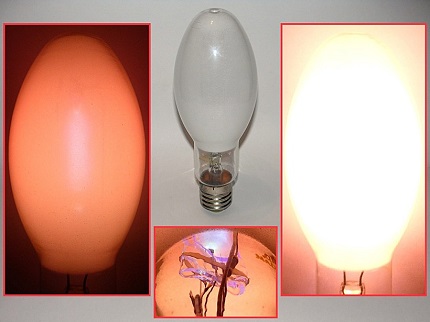
The voltaic arc in mercury vapor creates a glow of unacceptable color rendition of predominantly blue-green hues. The phosphor is responsible for converting UV radiation into red tones of light. The combination of colors gives a white cold glow of a DRL bulb.
Application specifics: pros and cons of lamps
DRL type illuminators are mainly installed on poles to illuminate streets, roads, parks, adjoining territories and non-residential buildings. This is due to the technical and operational features of the lamps.
The main advantage of mercury-arc devices is high power, which provides high-quality lighting of spacious areas and large facilities.
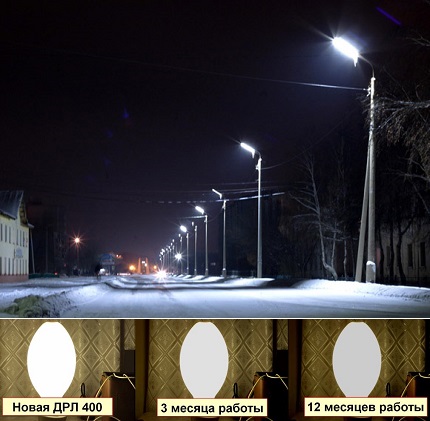
Additional advantages include:
- Durability. The average working life claimed by manufacturers is 12 thousand hours. At the same time, the more powerful the lamp, the longer it will last.
- Work at low temperatures. This is a crucial parameter when choosing a lighting fixture for the street. Gas discharge lamps are frost-resistant and retain their performance at sub-zero temperatures.
- Good brightness and angle of illumination. The light output of DRL devices, depending on their power, ranges from 45-60 Lm / V. Thanks to the operation of the quartz burner and the phosphor coating of the bulb, a uniform light distribution with a wide scattering angle is achieved.
- Compactness. The lamps are relatively small, the product length at 125 W is about 18 cm, the device at 145 W is 41 cm. The diameter is 76 and 167 mm, respectively.
One of the features of using DRL illuminators is the need to connect to the network through throttle. The role of an intermediary is to limit the current supplying the bulb. If you connect a lighting device bypassing the inductor, then it will burn out due to the large electric current.
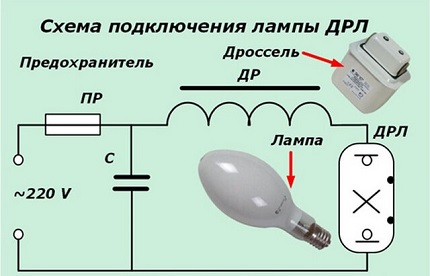
A number of disadvantages limits the use of DRL-lamps in everyday life.
Significant disadvantages:
- Duration of ignition. Exit to full illumination - up to 15 minutes. It takes time to heat up mercury, which is very inconvenient in a home environment.
- Sensitivity to power quality. If the voltage is reduced by 20% or more from the nominal value, the mercury lamp will not turn on, and the luminous device will go out.When the indicator decreases by 10-15%, the brightness of the light deteriorates by 25-30%.
- Noise at work. The DRL lamp makes a buzzing sound, not noticeable on the street, but noticeable in the room.
- Ripple. Despite the use of a stabilizer, the lamps flicker - it is undesirable to perform long-term work in such lighting.
- Low color rendering. The parameter characterizes the reality of the perception of surrounding colors. The recommended color rendering index for residential premises is at least 80, optimally 90-97. In DRL lamps, the value of the indicator does not reach 50. In such lighting, it is not possible to clearly distinguish between shades and colors.
- Insecure use. In the process, ozone is released, therefore, when operating the lamp indoors, the organization of a high-quality ventilation system is required.
In addition, the presence of mercury in a flask in itself is a potential hazard. Such bulbs cannot be simply thrown away after use. In order not to pollute the environment, they are disposed of appropriately.
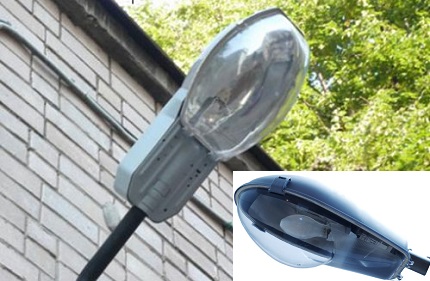
A significant minus of the DRL of illuminators is the inability to re-enable until the lamp is completely cooled. When the device is operating, the gas pressure inside the glass flask rises significantly (up to 100 kPa). Until the lamp cools down, it is impossible to break through the spark gap with a starting voltage. Re-activation occurs after about a quarter of an hour.
Selection Criteria: Evaluation of Technical Indicators
When determining the best option for a lighting device, the following characteristics should be taken into account:
- power;
- cap shape / size;
- brightness of a light stream;
- duration of work.
Power. When choosing this option, you should focus on the purpose and location of the lamp. If the device is bought to illuminate the road, then we must take into account the distance between the lamps - the larger it is, the more productive the lamps should be.
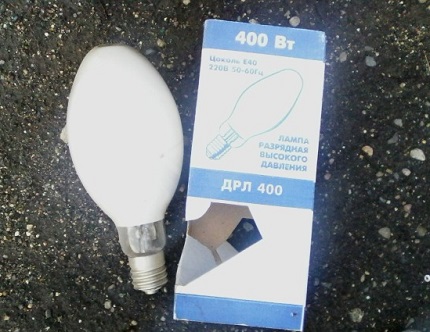
Light flow. The main indicator of light radiation directed in different directions. The parameter is measured in lumens (Lm). It is by this criterion, and not by power, that it is necessary to compare the performance of different types of lamps.

Significant energy savings - a powerful argument in favor of LEDs. The high cost of LED-lamps pays off in the first year of operation.
Basement DRL illuminators are available with the two most popular types of socles:
- E27 - screw form, diameter - 27 mm. Such a base is equipped with mercury-arc devices of 80 W and 125 W.
- E40 - the largest size of the category "E". A 40 mm base is used in lamps of 250 W and above, designed to illuminate spacious areas.
In addition to the type of twisting into the cartridge, the dimensions of the lampshade should also be taken into account.
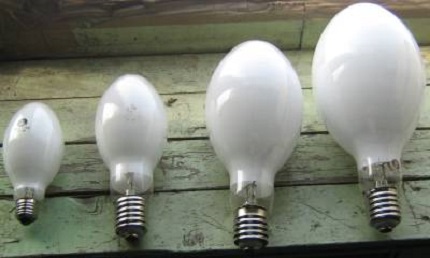
Service life. This parameter is largely determined by the quality of manufacturing, namely the responsibility of the manufacturer. It is better to choose lamps with a maximum service life. As a rule, high-power devices have a longer life.
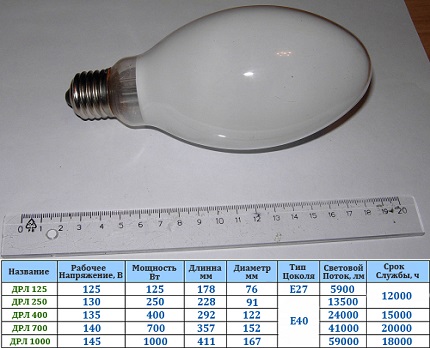
Part of the information about the characteristics of the lamps is in the marking.In domestic practice, the letter abbreviation denotes the name of the illuminator, digital - power. The production of mercury lamps is regulated by GOST 27682-88 and GOST 53074-2008.
Foreign products of the DRL type according to the international ILCOS system are labeled QE. Some manufacturers adhere to the pan-European ZVEI and German LBS naming conventions.
Markers of mercury lamps of popular companies:
- HPL - Philips;
- HRL - Radium;
- MBF - General Electric;
- HQL - Osram;
- HSL and HSB - Sylvania.
Additional designations according to ILCOS: QB - models with integrated ballast, QG - spherical bulb, QR - lamps with a reflective inner layer.
Which manufacturer should I prefer?
It is recommended to choose products of well-known brands, it is better to refrain from buying cheap "nameless" Chinese bulbs.
The following manufacturers won confidence among buyers. mercury devices:
- Osram (Germany);
- Philips (Netherlands);
- General Electric (USA / Hungary);
- Next (Poland);
- Eurosvet (Ukraine);
- Lisma (Russia);
- DeLux (China).
In the European market, two brands are considered the leaders in the production and sale of lighting products: Osram and Philips. Both companies have many years of experience - over a century, a wide range and an extensive sales network.
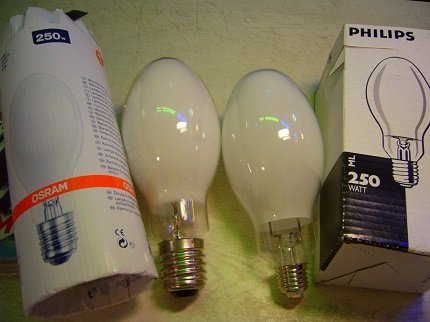
The factories of the American company General Electric are also located in Europe. The quality of the goods and the service life are not inferior to previous brands, and the price is slightly lower. For a DRL illuminator with a power of 250 W, you need to pay about 7 cu
E.Next is an electrotechnical holding, where the main manufacturer of devices is the group of Polish companies Tarel. The product line features numerous series of different lamps for home, street and industrial lighting.
Compared to German and Dutch lamps of similar power, E.Next 250W illuminators are inferior to competitors in color rendering (Ra = 40) and durability (12000 hours). Estimated price - 5 cu
Mercury-arc lamps of Russian, Ukrainian and Chinese branded production are in the same price category, the average cost of products per 250 W is 3 cu The disadvantage of lighting devices is their limited operation - according to the passport data, the bulbs will last 5,000 hours.
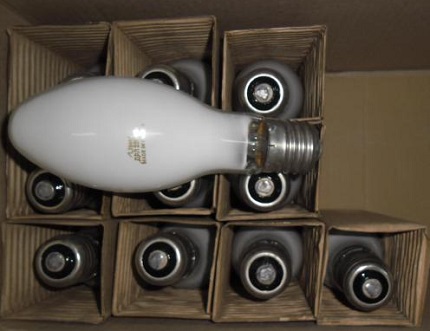
Comparison of DRL bulbs with analogues
Discharge lamps are often compared with each other and with more advantageous LEDs. The closest analogues to DRL are three types of illuminators: DRV, DRI and DNaT. Let's try to identify the features and competitive advantages of different bulbs.
DRV. The mercury-tungsten arc bulb is very similar in design and operation principle to DRL. Structurally, inside the bulb there is a mercury discharge burner and a tungsten spiral. The last element limits the current for the burner, which means that additional ballasts are not needed.
The main differences between mercury-tungsten lamps from DRL:
- spend more electricity - luminous flux DRV 250 no more than 5500 Lm;
- Estimated time of work - 3000 hours;
- light up for 1 minute.
DRI. Arc mercury bulbs with radiating additives: indium, sodium, waist, etc. halogenite. Metal components increase the light output of devices to 75-90 Lm / W.

DNT. Sodium arc lamps boast maximum light output and a long operating period among discharge illuminators. Performance sodium light bulbs over time, it is not reduced as noticeably as DRL lamps.
Characteristics of DNaT:
- maximum light output - 125 Lm / W;
- working capacity - within 20 thousand hours;
- relative stability of parameters;
- wide range of operating temperatures;
- reaching maximum illumination in 5-7 minutes.
Cons of sodium light sources: significant ripple and low color rendering, Ra = 25. The radiation spectrum is dominated by red and yellow colors.
Discharge lamps confidently give way to LED options. LED devices surpass their predecessors in all technical and operational parameters.
Indisputable advantages of LEDs: environmental friendliness, minimal ripple, durability, instant inclusion, excellent color reproduction and contrast. In addition to excellent operational characteristicsdiode devices have temperature and mechanical resistance.

Mercury disposal requirements
Thoughtlessly throwing away spent or defective mercury-containing bulbs is not allowed. Devices with a damaged bulb are a serious threat to human health and the environment as a whole, therefore they need specific disposal.
The issue of the procedure for disposal of unsafe waste is relevant for both business owners and ordinary residents. The processing of mercury lamps is carried out by organizations that have received the appropriate license.
The company enters into a service agreement with such a company. Upon request, the representative of the disposal company visits the facility, collects and removes lamps for subsequent disinfection and processing. Estimated cost of the service - 0.5 cu for one lighting device.
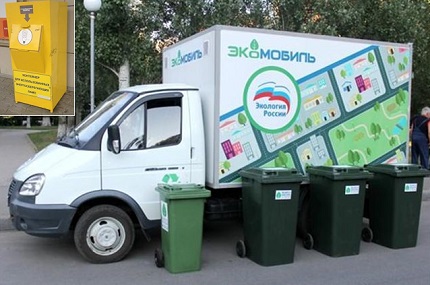
If the surge mercury-containing lamps Since enterprises are somehow controlled by supervisory authorities, the observance of disposal rules by the population is the personal responsibility of citizens.
Unfortunately, due to low awareness, not every user of mercury lamps is aware of the possible consequences of mercury vapor entering the surrounding atmosphere.
All types of energy-saving lamps are described in detail in next article, in which the principles of action are considered, a comparison of devices is made, a simplified economic assessment is given.
Conclusions and useful video on the topic
In the proposed video review, the design of the DRL illuminator is described, the principle of operation is described in detail, and the main nuances of operation are noted:
DRL type discharge lamps are still used in street lighting. The main argument in favor of mercury devices is a powerful luminous flux and affordable cost. However, they are gradually replaced by more advanced lamps, which along with high efficiency can boast of good quality of luminescence and safety of use.
Please write comments in the block below, ask questions and post photos on the topic of the article. Share useful information that will be interesting and useful to site visitors. Tell us about your experience in choosing and installing a high-pressure discharge lamp.

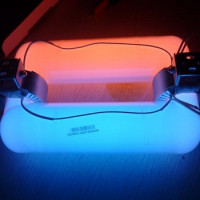 Induction lamps: device, types, scope + rules of choice
Induction lamps: device, types, scope + rules of choice 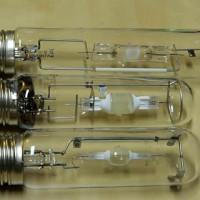 Metal halide lamps: types, device, pros and cons + selection rules
Metal halide lamps: types, device, pros and cons + selection rules 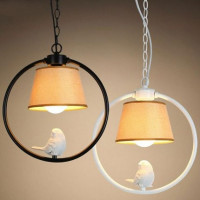 220V LED lamps: characteristics, marking, selection criteria + review of the best brands
220V LED lamps: characteristics, marking, selection criteria + review of the best brands 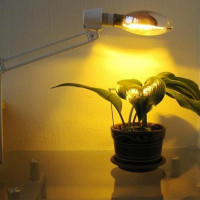 Sodium lamps: varieties, technical parameters, scope + rules of choice
Sodium lamps: varieties, technical parameters, scope + rules of choice  LED table lamps: types, selection rules + review of the best manufacturers
LED table lamps: types, selection rules + review of the best manufacturers 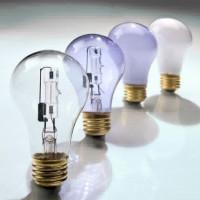 Halogen lamps: device, varieties, nuances of choice + review of the best manufacturers
Halogen lamps: device, varieties, nuances of choice + review of the best manufacturers  How much does it cost to connect gas to a private house: the price of organizing gas supply
How much does it cost to connect gas to a private house: the price of organizing gas supply  The best washing machines with dryer: model rating and customer tips
The best washing machines with dryer: model rating and customer tips  What is the color temperature of light and the nuances of choosing the temperature of the lamps to suit your needs
What is the color temperature of light and the nuances of choosing the temperature of the lamps to suit your needs  Replacement of a geyser in an apartment: replacement paperwork + basic norms and requirements
Replacement of a geyser in an apartment: replacement paperwork + basic norms and requirements
This, of course, is interesting, but it does not seem to you that these lamps have too many minuses. The presence of mercury, the release of ozone - this is very harmful to the outside world. It’s time to change the city lighting for a more environmentally friendly option. What is the use of a lamp that flares up for a long time, cracking and barely shining? In our city there are no collection points for the disposal of hazardous appliances (mercury-containing lamps, batteries, batteries, etc.)
In almost all settlements there are reception centers for energy-saving lamps and DRL lamps, just not everyone knows about them. Any construction or hardware store, management company, Ministry of Emergencies. If the village is small, and there is nothing listed in it, and there is no way to go to the city, then you can turn in such lamps to the village administration.
Often in stores people refuse to accept waste lamps, but this is illegal. Any such store is required to enter into an agreement with a recycling company.